A Comprehensive Survey on Real-Time Applications of WSN
Abstract
:1. Introduction
Framework/Layout of the Study
2. Types and Requirements of WSN
2.1. Terrestrial Wireless Sensor Network
2.2. Underground Wireless Sensor Network
2.3. Underwater Wireless Sensor Network
2.4. Mobile Wireless Sensor Network
2.5. Multimedia Wireless Sensor Network
Some Key Requirements of Wireless Sensor Networks
- Scalability: It will expand this network to add nodes as required. Its expansions should be easy to conduct.
- Reliability: Many methods are there for reducing the power usage of (WSN) nodes, which are resulting in an increase in the lifetime of the network and their consistency.
- Responsiveness: The response time is very quick because of its limitations.
- Mobility: Mobility is the basic feature of WSN. It is a wireless network so no wire is used for this network. That is why mobility is a key requirement of WSN.
- Power efficiency: It uses a sensor that results in low power consumption.
3. Applications of WSN
3.1. Environment Monitoring
3.1.1. Autonomy
3.1.2. Reliability
3.1.3. Robustness
3.2. Green Houses
3.3. Industrial and Business Uses
3.4. In the Livestock
3.5. Habitat Monitoring
3.6. Forest Monitoring
3.7. Underwater Sensor Network
3.8. WSN and Health
Wireless Body Area Network (WBAN)
- Level 1: First level of WBAN architecture is called the body sensor unit that is based on one or more body sensor units and are placed outside or inside of the human body. This sensor gets required data from the human body and sends it wirelessly to the next layer.
- Level 2: Second layer is called the body central unit. The body central unit contains personal servers, and these servers get data from sensors which calculate and manipulate this data, generating the required results. This layer can be based on a wireless computer system, an Android mobile phone, or any GPS supported system that can manipulate received data.
- Level 3: Third layer based on end user’s machines where end users are medical assistance or physicians and their machines can be a computer or mobile phones. These machines gather the required information from layer two, and ask end users to provide a response for a patient’s fitness. If there are some emergency results, then the machine sends an alarm to the end user and makes it possible to generate a quick response so that patients can get proper treatment.
3.9. WSN and VANET
WSN and Automated Vehicles
3.10. WSN and Military
4. SWOT (Strength, Weakness, Opportunities, and Threat) Analysis of WSNs
5. Conclusions
Acknowledgments
Author Contributions
Conflicts of Interest
References
- Akyildiz, I.; Su, W.; Sankarasubramaniam, Y.; Cayirci, E. Wireless sensor networks: A survey. Comput. Netw. 2002, 38, 393–422. [Google Scholar] [CrossRef]
- Zhou, Y.; Fang, Y.; Zhang, Y. Securing wireless sensor networks: A survey. IEEE Commun. Surv. Tutor. 2008, 10, 6–28. [Google Scholar] [CrossRef]
- Diamond, S.; Ceruti, M. Application of Wireless Sensor Network to Military Information Integration. In Proceedings of the 2007 5th IEEE International Conference on Industrial Informatics, Vienna, Austria, 23–27 July 2007. [Google Scholar]
- Alemdar, H.; Ersoy, C. Wireless sensor networks for healthcare: A survey. Comput. Netw. 2010, 54, 2688–2710. [Google Scholar] [CrossRef]
- Bal, M. Industrial applications of collaborative Wireless Sensor Networks: A survey. In Proceedings of the 2014 IEEE 23rd International Symposium on Industrial Electronics (ISIE), Istanbul, Turkey, 1–4 June 2014. [Google Scholar]
- Chee-Yee, C.; Kumar, S. Sensor networks: Evolution, opportunities, and challenges. Proc. IEEE 2003, 91, 1247–1256. [Google Scholar] [CrossRef]
- Barroca, N.; Borges, L.; Velez, F.; Monteiro, F.; Górski, M.; Castro-Gomes, J. Wireless sensor networks for temperature and humidity monitoring within concrete structures. Constr. Build. Mater. 2013, 40, 1156–1166. [Google Scholar] [CrossRef]
- Li, M.; Lin, H. Design and Implementation of Smart Home Control Systems Based on Wireless Sensor Networks and Power Line Communications. IEEE Trans. Ind. Electron. 2015, 62, 4430–4442. [Google Scholar] [CrossRef]
- Sandhu, M.; Javaid, N.; Jamil, M.; Khan, Z.; Imran, M.; Ilahi, M.; Khan, M. Modeling mobility and psychological stress based human postural changes in wireless body area networks. Comput. Hum. Behav. 2015, 51, 1042–1053. [Google Scholar] [CrossRef]
- Basagni, S.; Carosi, A.; Petrioli, C.; Phillips, C. Coordinated and controlled mobility of multiple sinks for maximizing the lifetime of wireless sensor networks. Wirel. Netw. 2011, 17, 759–778. [Google Scholar] [CrossRef]
- Honjo, T.; Yamato, H.; Mikami, T.; Grimmond, C. Network optimization for enhanced resilience of urban heat island measurements. Sustain. Cities Soc. 2015, 19, 319–330. [Google Scholar] [CrossRef]
- Yu, T.; Lin, C.; Chen, C.; Lee, W.; Lee, R.; Tseng, C.; Liu, S. Wireless sensor networks for indoor air quality monitoring. Med. Eng. Phys. 2013, 35, 231–235. [Google Scholar] [CrossRef] [PubMed]
- Gkikopouli, A.; Nikolakopoulos, G.; Manesis, S. A survey on Underwater Wireless Sensor Networks and applications. In Proceedings of the 2012 20th Mediterranean Conference on Control & Automation (MED), Barcelona, Spain, 3–6 July 2012. [Google Scholar]
- Nadeem, F.; Leitgeb, E.; Awan, M.; Chessa, S. Comparing the Life Time of Terrestrial Wireless Sensor Networks by Employing Hybrid FSO/RF and Only RF Access Networks. In Proceedings of the 2009 Fifth International Conference on Wireless and Mobile Communications, Cannes, France, 23–29 August 2009. [Google Scholar]
- AL-Kadi, T.; AL-Tuwaijri, Z.; AL-Omran, A. Wireless Sensor Networks for Leakage Detection in Underground Pipelines: A Survey Paper. Procedia Comput. Sci. 2013, 21, 491–498. [Google Scholar] [CrossRef]
- Sun, Z.; Akyildiz, I.; Hancke, G. Dynamic Connectivity in Wireless Underground Sensor Networks. IEEE Trans. Wirel. Commun. 2011, 10, 4334–4344. [Google Scholar] [CrossRef]
- Zaman, I.; Gellhaar, M.; Dede, J.; Koehler, H.; Foerster, A. Demo: Design and Evaluation of MoleNet for Wireless Underground Sensor Networks. In Proceedings of the 2016 IEEE 41st Conference on Local Computer Networks Workshops (LCN Workshops), Dubai, UAE, 7–10 November 2016. [Google Scholar]
- Ayaz, M.; Baig, I.; Abdullah, A.; Faye, I. A survey on routing techniques in underwater wireless sensor networks. J. Netw. Comput. Appl. 2011, 34, 1908–1927. [Google Scholar] [CrossRef]
- Anguita, D.; Brizzolara, D.; Parodi, G. Building an Underwater Wireless Sensor Network Based on Optical: Communication: Research Challenges and Current Results. In Proceedings of the 2009 Third International Conference on Sensor Technologies and Applications, Athens/Glyfada, Greece, 18–23 June 2009. [Google Scholar]
- Goyal, N.; Dave, M.; Verma, A. Data aggregation in underwater wireless sensor network: Recent approaches and issues. J. King Saud Univ. Comput. Inf. Sci. 2017. [Google Scholar] [CrossRef]
- Tonneau, A.; Mitton, N.; Vandaele, J. A Survey on (mobile) Wireless Sensor Network Experimentation Testbeds. In Proceedings of the 2014 IEEE International Conference on Distributed Computing in Sensor Systems, Marina Del Rey, CA, USA, 26–28 May 2014. [Google Scholar]
- Cho, J.; Swami, A.; Chen, I. A Survey on Trust Management for Mobile Ad Hoc Networks. IEEE Commun. Surv. Tutor. 2011, 13, 562–583. [Google Scholar] [CrossRef]
- Shen, H.; Bai, G. Routing in wireless multimedia sensor networks: A survey and challenges ahead. J. Netw. Comput. Appl. 2016, 71, 30–49. [Google Scholar] [CrossRef]
- Akyildiz, I.; Melodia, T.; Chowdhury, K. A survey on wireless multimedia sensor networks. Comput. Netw. 2007, 51, 921–960. [Google Scholar] [CrossRef]
- Hayat, M.; Khan, H.; Iqbal, Z.; Ur Rahman, Z.; Tahir, M. Multimedia sensor networks: Recent trends, research challenges and future directions. In Proceedings of the 2017 International Conference on Communication, Computing and Digital Systems (C-CODE), Islamabad, Pakistan, 8–9 March 2017. [Google Scholar]
- Othman, M.; Shazali, K. Wireless Sensor Network Applications: A Study in Environment Monitoring System. Procedia Eng. 2012, 41, 1204–1210. [Google Scholar] [CrossRef]
- Boustani, A.; Girod, L.; Offenhuber, D.; Britter, R.; Wolf, M.; Lee, D.; Miles, S.; Biderman, A.; Ratti, C. Investigation of the waste-removal chain through pervasive computing. IBM J. Res. Dev. 2011, 55, 11:1–11:11. [Google Scholar] [CrossRef]
- Mao, X.; Miao, X.; He, Y.; Li, X.; Liu, Y. CitySee: Urban CO2 monitoring with sensors. In Proceedings of the 2012 IEEE INFOCOM, Orlando, FL, USA, 25–30 March 2012. [Google Scholar]
- Hasenfratz, D.; Saukh, O.; Walser, C.; Hueglin, C.; Fierz, M.; Arn, T.; Beutel, J.; Thiele, L. Deriving high-resolution urban air pollution maps using mobile sensor nodes. Pervasive Mob. Comput. 2015, 16, 268–285. [Google Scholar] [CrossRef]
- Jiang, Q.; Kresin, F.; Bregt, A.; Kooistra, L.; Pareschi, E.; van Putten, E.; Volten, H.; Wesseling, J. Citizen Sensing for Improved Urban Environmental Monitoring. J. Sens. 2016, 2016. [Google Scholar] [CrossRef]
- Ahonen, T.; Virrankoski, R.; Elmusrati, M. Greenhouse Monitoring with Wireless Sensor Network. In Proceedings of the 2008 IEEE/ASME International Conference on Mechtronic and Embedded Systems and Applications, Beijing, China, 12–15 October 2008. [Google Scholar]
- Farm Management. Available online: http://www.farmmanagement.pro/the-use-of-wireless-sensor-networks-in-precision-agriculture (accessed on 15 September 2017).
- Pahuja, R.; Verma, H.; Uddin, M. A Wireless Sensor Network for Greenhouse Climate Control. IEEE Pervasive Comput. 2013, 12, 49–58. [Google Scholar] [CrossRef]
- Liu, J. Design and Implementation of an Intelligent Environmental-Control System: Perception, Network, and Application with Fused Data Collected from Multiple Sensors in a Greenhouse at Jiangsu, China. Int. J. Distrib. Sens. Netw. 2016, 12, 5056460. [Google Scholar] [CrossRef]
- Queiroz, D.; Alencar, M.; Gomes, R.; Fonseca, I.; Benavente-Peces, C. Survey and systematic mapping of industrial Wireless Sensor Networks. J. Netw. Comput. Appl. 2017, 97, 96–125. [Google Scholar] [CrossRef]
- Ni, D.; Chin, C. Sensor Network for Gas Meter Application. In Proceedings of the 2009 Third International Conference on Sensor Technologies and Applications, Athens/Glyfada, Greece, 18–23 June 2009. [Google Scholar]
- Chen, C.; Lee, D. Energy Saving Effects of Wireless Sensor Networks: A Case Study of Convenience Stores in Taiwan. Sensors 2011, 11, 2013–2034. [Google Scholar] [CrossRef] [PubMed]
- Valverde, J.; Rosello, V.; Mujica, G.; Portilla, J.; Uriarte, A.; Riesgo, T. Wireless Sensor Network for Environmental Monitoring: Application in a Coffee Factory. Int. J. Distrib. Sens. Netw. 2012, 8, 638067. [Google Scholar] [CrossRef]
- Schirrmann, M.; Gebbers, R.; Kramer, E.; Seidel, J. Soil pH Mapping with an On-The-Go Sensor. Sensors 2011, 11, 573–598. [Google Scholar] [CrossRef] [PubMed]
- Neethirajan, S. Recent advances in wearable sensors for animal health management. Sens. Bio-Sens. Res. 2017, 12, 15–29. [Google Scholar] [CrossRef]
- Wark, T.; Corke, P.; Sikka, P.; Klingbeil, L.; Guo, Y.; Crossman, C.; Valencia, P.; Swain, D.; Bishop-Hurley, G. Transforming Agriculture through Pervasive Wireless Sensor Networks. IEEE Pervasive Comput. 2007, 6, 50–57. [Google Scholar] [CrossRef] [Green Version]
- Mashoko Nkwari, P.; Rimer, S.; Paul, B. Cattle monitoring system using wireless sensor network in order to prevent cattle rustling. In Proceedings of the 2014 IST-Africa Conference, Le Meridien Ile Maurice, Mauritius, 7–9 May 2014. [Google Scholar]
- Wamuyu, P. A Conceptual Framework for Implementing a WSN Based Cattle Recovery System in Case of Cattle Rustling in Kenya. Technologies 2017, 5, 54. [Google Scholar] [CrossRef]
- Dessart, N.; Hunel, P. Data collection using WSN for counting individuals and habitat characterization. J. Comput. Sci. 2014, 5, 624–632. [Google Scholar] [CrossRef]
- Stattner, E.; Vidot, N.; Hunel, P.; Collard, M. Wireless sensor network for habitat monitoring: A counting heuristic. In Proceedings of the 37th Annual IEEE Conference on Local Computer Networks—Workshops, Clearwater Beach, FL, USA, 22–25 October 2012. [Google Scholar]
- Mainwaring, A.; Culler, D.; Polastre, J.; Szewczyk, R.; Anderson, J. Wireless sensor networks for habitat monitoring. In Proceedings of the 1st ACM International Workshop on Wireless Sensor Networks and Applications—WSNA′02, Atlanta, GA, USA, 28 September 2002. [Google Scholar]
- Naumowicz, T.; Freeman, R.; Kirk, H.; Dean, B.; Calsyn, M.; Liers, A.; Braendle, A.; Guilford, T.; Schiller, J. Wireless Sensor Network for habitat monitoring on Skomer Island. In Proceedings of the 2010 IEEE 35th Conference onLocal Computer Networks (LCN), Denver, CO, USA, 10–14 October 2010. [Google Scholar]
- Jan, M.; Nanda, P.; He, X.; Liu, R. A Sybil attack detection scheme for a forest wildfire monitoring application. Future Gener. Comput. Syst. 2016. [Google Scholar] [CrossRef]
- Gaikwad, S.; Patil, R.; Khandare, A.; Rai, A. Design WSN node for protection of forest trees against poaching based on ZigBee. In Proceedings of the 2015 IEEE International Conference on Electronics, Computing and Communication Technologies (CONECCT), Bangalore, India, 10–11 July 2015. [Google Scholar]
- The Dynamics of Forest Canopy Motion. Available online: http://today.uconn.edu/2010/01/the-dynamics-of-forest-canopy-motion/ (accessed on 15 September 2017).
- Son, B.; Her, Y.; Kim, J. A Design and Implementation of Forest-Fires Surveillance System based on Wireless Sensor Network for South Korea Mountains. Int. J. Comput. Sci. Netw. Secur. 2006, 6, 9B. [Google Scholar]
- Hefeeda, M.; Bagheri, M. Wireless Sensor Networks for Early Detection of Forest Fires. In Proceedings of the 2007 IEEE Internatonal Conference on Mobile Adhoc and Sensor Systems, Pisa, Italy, 8–11 October 2007. [Google Scholar]
- Kim, D.; Cano, J.; Wang, W.; De Rango, F.; Hua, K. Underwater Wireless Sensor Networks 2015. Int. J. Distrib. Sens. Netw. 2015, 11, 623042. [Google Scholar] [CrossRef]
- Zenia, N.; Aseeri, M.; Ahmed, M.; Chowdhury, Z.; Shamim Kaiser, M. Energy-efficiency and reliability in MAC and routing protocols for underwater wireless sensor network: A survey. J. Netw. Comput. Appl. 2016, 71, 72–85. [Google Scholar] [CrossRef]
- Ilyas, N.; Akbar, M.; Ullah, R.; Khalid, M.; Arif, A.; Hafeez, A.; Qasim, U.; Khan, Z.; Javaid, N. SEDG: Scalable and Efficient Data Gathering Routing Protocol for Underwater WSNs. Procedia Comput. Sci. 2015, 52, 584–591. [Google Scholar] [CrossRef]
- Water Quality Monitoring in Europe’s Largest Fluvial Aquarium. Available online: http://www.libelium.com/water-quality-monitoring-europe-largest-fluvial-aquarium-zaragoza/ (accessed on 15 November 2017).
- Gray, A.; Sadler, J.; Kit, O.; Kyzirakos, K.; Karpathiotakis, M.; Calbimonte, J.; Page, K.; García-Castro, R.; Frazer, A.; Galpin, I.; et al. A Semantic Sensor Web for Environmental Decision Support Applications. Sensors 2011, 11, 8855–8887. [Google Scholar] [CrossRef] [PubMed]
- Whittle, A.J.; Allen, M.; Preis, A.; Iqbal, M. Sensor Networks for Monitoring and Control of Water Distribution Systems. In Proceedings of the 6th International Conference on Structural Health Monitoring of Intelligent Infrastructure (SHMII), Hong Kong, China, 9–11 December 2013. [Google Scholar]
- Kim, H.; Cho, H. SOUNET: Self-Organized Underwater Wireless Sensor Network. Sensors 2017, 17, 283. [Google Scholar] [CrossRef] [PubMed]
- Milenković, A.; Otto, C.; Jovanov, E. Wireless sensor networks for personal health monitoring: Issues and an implementation. Comput. Commun. 2006, 29, 2521–2533. [Google Scholar] [CrossRef]
- Ko, J.; Gao, T.; Terzis, A. Empirical study of a medical sensor application in an urban emergency department. In Proceedings of the 4th International ICST Conference on Body Area Networks, Los Angeles, CA, USA, 1–3 April 2009. [Google Scholar]
- Hii, P.; Chung, W. A Comprehensive Ubiquitous Healthcare Solution on an Android™ Mobile Device. Sensors 2011, 11, 6799–6815. [Google Scholar] [CrossRef] [PubMed]
- Kakria, P.; Tripathi, N.; Kitipawang, P. A Real-Time Health Monitoring System for Remote Cardiac Patients Using Smartphone and Wearable Sensors. Int. J. Telemed. Appl. 2015, 2015, 1–11. [Google Scholar] [CrossRef] [PubMed]
- Yan, S.; Ma, H.; Li, P.; Song, G.; Wu, J. Development and Application of a Structural Health Monitoring System Based on Wireless Smart Aggregates. Sensors 2017, 17, 1641. [Google Scholar] [CrossRef] [PubMed]
- Yuce, M. Implementation of wireless body area networks for healthcare systems. Sens. Actuators A Phys. 2010, 162, 116–129. [Google Scholar] [CrossRef]
- Salehi, S.; Razzaque, M.; Tomeo-Reyes, I.; Hussain, N. IEEE 802.15.6 standard in wireless body area networks from a healthcare point of view. In Proceedings of the 2016 22nd Asia-Pacific Conference on Communications (APCC), Yogyakarta, Indonesia, 25–27 August 2016. [Google Scholar]
- Lv, Z.; Xia, F.; Wu, G.; Yao, L.; Chen, Z. iCare: A Mobile Health Monitoring System for the Elderly. In Proceedings of the 2010 IEEE/ACM Int’l Conference on Green Computing and Communications & Int’l Conference on Cyber, Physical and Social Computing, Hangzhou, China, 18–20 December 2010. [Google Scholar]
- Megalingam, R.; Radhakrishnan, V.; Jacob, D.; Unnikrishnan, D.; Sudhakaran, A. Assistive Technology for Elders: Wireless Intelligent Healthcare Gadget. In Proceedings of the 2011 IEEE Global Humanitarian Technology Conference, Seattle, WA, USA, 30 October–1 November 2011. [Google Scholar]
- Woon-Sung, B.; Dong-Min, K.; Bashir, F.; Pyun, J.Y. Real life applicable fall detection system based on wireless body area network. In Proceedings of the 2013 IEEE 10th Consumer Communications and Networking Conference (CCNC), Las Vegas, NV, USA, 11–14 January 2013. [Google Scholar]
- Kantoch, E.; Augustyniak, P.; Markiewicz, M.; Prusak, D. Monitoring activities of daily living based on wearable wireless body sensor network. In Proceedings of the 2014 36th Annual International Conference of the IEEE Engineering in Medicine and Biology Society, Chicago, IL, USA, 26–30 August 2014. [Google Scholar]
- Al Rasyid, M.; Lee, B.; Sudarsono, A. Wireless body area network for monitoring body temperature, heart beat and oxygen in blood. In Proceedings of the 2015 International Seminar on Intelligent Technology and Its Applications (ISITIA), Surabaya, Indonesia, 20–21 May 2015. [Google Scholar]
- Rasyid, M.; Saputra, F.; Christian, A. Implementation of blood glucose levels monitoring system based on Wireless Body Area Network. In Proceedings of the 2016 IEEE International Conference on Consumer Electronics-Taiwan (ICCE-TW), Nantou, Taiwan, 27–29 May 2016. [Google Scholar]
- Wu, T.; Wu, F.; Redoute, J.; Yuce, M. An Autonomous Wireless Body Area Network Implementation Towards IoT Connected Healthcare Applications. IEEE Access 2017, 5, 11413–11422. [Google Scholar] [CrossRef]
- Tariq, S.; Hyunsoo, C.; Wasiq, C. Heemin Park Controlled parking for self-driving cars. In Proceedings of the 2016 IEEE International Conference on Systems, Man, and Cybernetics (SMC), Budapest, Hungary, 9–12 October 2016. [Google Scholar]
- Chatrapathi, C.; Rajkumar, M.; Venkatesakumar, V. VANET based integrated framework for smart accident management system. In Proceedings of the 2015 International Conference on Soft-Computing and Networks Security (ICSNS), Coimbatore, India, 25–27 February 2015. [Google Scholar]
- Taie, S.; Taha, S. A novel secured traffic monitoring system for VANET. In Proceedings of the 2017 IEEE International Conference on Pervasive Computing and Communications Workshops (PerCom Workshops), Kailua-Kona, HI, USA, 13–17 March 2017. [Google Scholar]
- You, Z.; Chen, S.; Wang, Y. Novel dynamic data aggregation scheme for WSN based intelligent vehicle systems. Intell. Decis. Technol. 2016, 10, 105–114. [Google Scholar] [CrossRef]
- Dagher, R.; Mitton, N.; Amadou, I. Towards WSN-aided navigation for vehicles in smart cities: An application case study. In Proceedings of the 2014 IEEE International Conference on Pervasive Computing and Communication Workshops (PERCOM WORKSHOPS), Budapest, Hungary, 24–28 March 2014. [Google Scholar]
- Srinivasan, R.; Sharmili, A.; Saravanan, S.; Jayaprakash, D. Smart vehicles with everything. In Proceedings of the 2016 2nd International Conference on Contemporary Computing and Informatics (IC3I), Greater Noida, India, 14–17 December 2016. [Google Scholar]
- Winkler, M.; Street, M.; Tuchs, K.; Wrona, K. Wireless Sensor Networks for Military Purposes. In Autonomous Sensor Network; Springer: Berlin/Heidelberg, Germany, 2012; pp. 365–394. [Google Scholar]
- Açar, G.; Adams, A. ACMENet: An underwater acoustic sensor network protocol for real-time environmental monitoring in coastal areas. IEE Radar Sonar Navig. 2006, 153, 365. [Google Scholar] [CrossRef]
- Arora, A.; Ramnath, R.; Ertin, E.; Sinha, P.; Bapat, S.; Naik, V.; Kulathumani, V.; Zhang, H.; Cao, H.; Sridharan, M.; et al. ExScal: Elements of an Extreme Scale Wireless Sensor Network. In Proceedings of the 11th IEEE International Conference on Embedded and Real-Time Computing Systems and Applications (RTCSA‘05), Hong Kong, China, 17–19 August 2005. [Google Scholar]


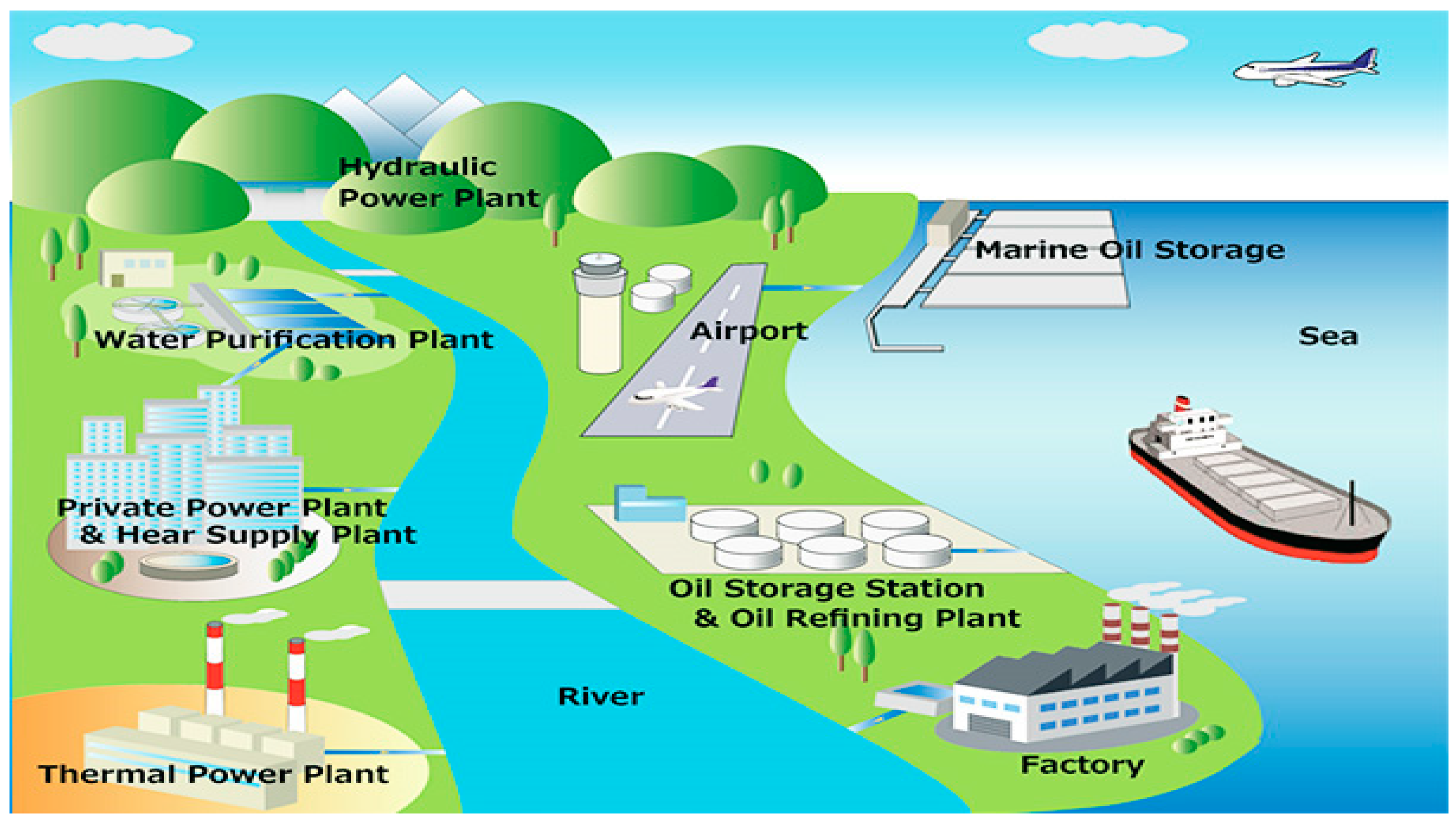
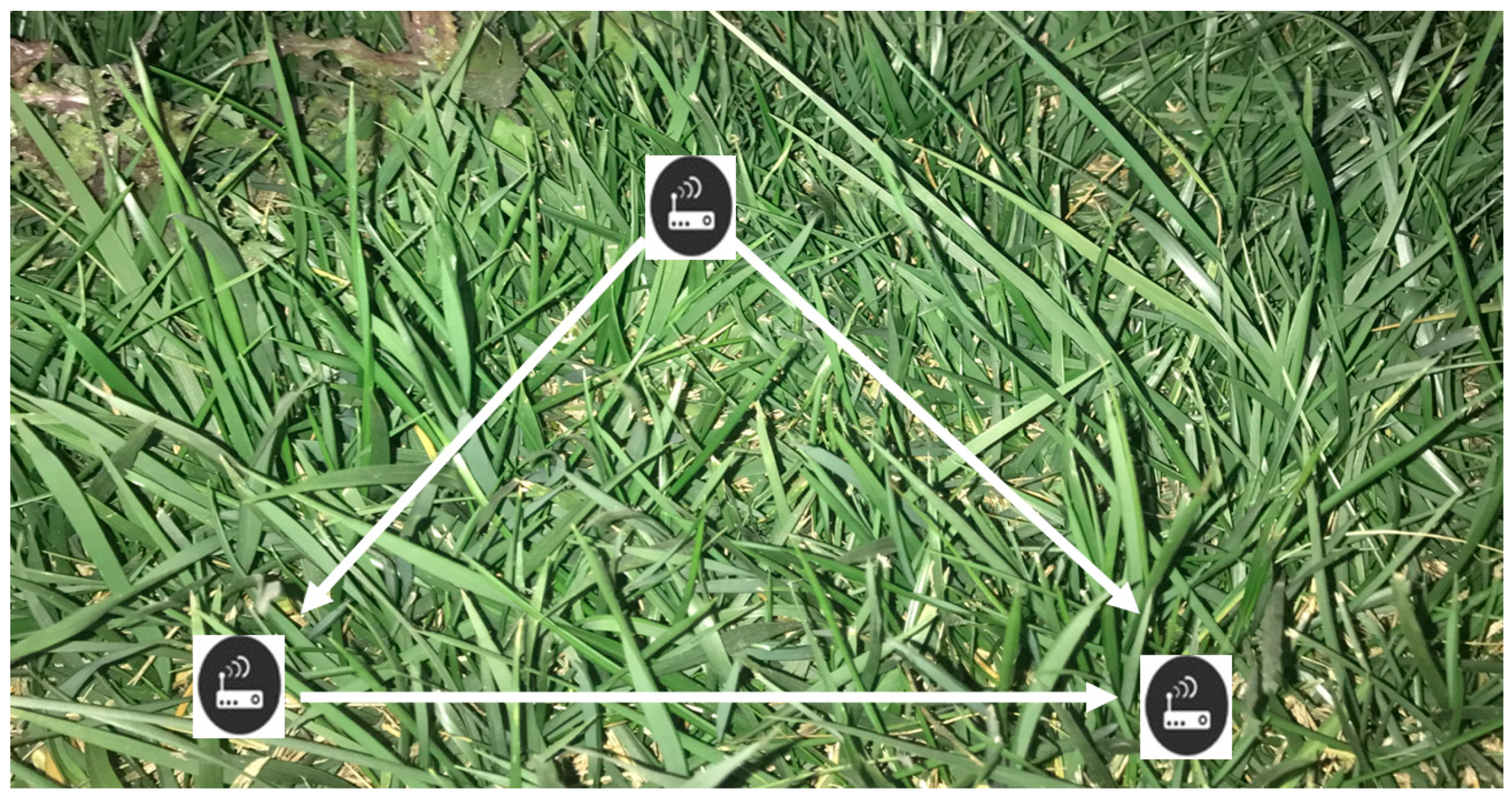

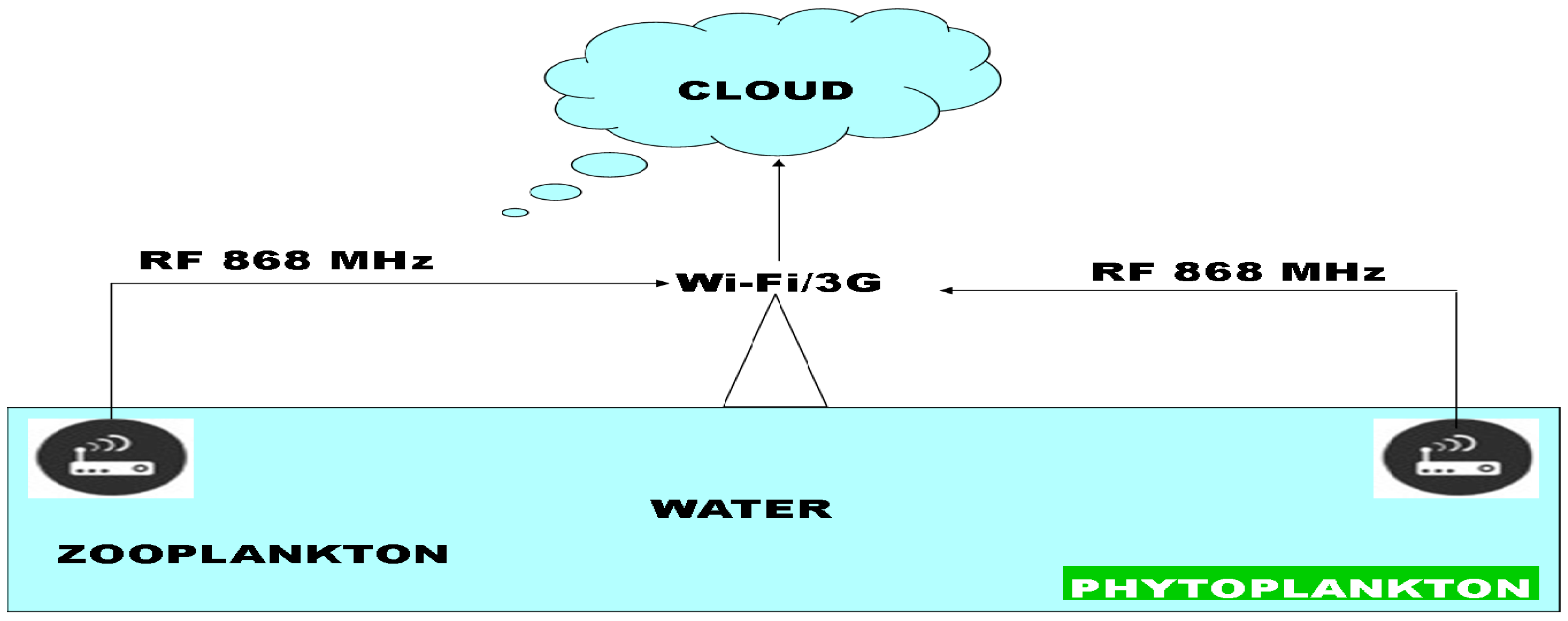
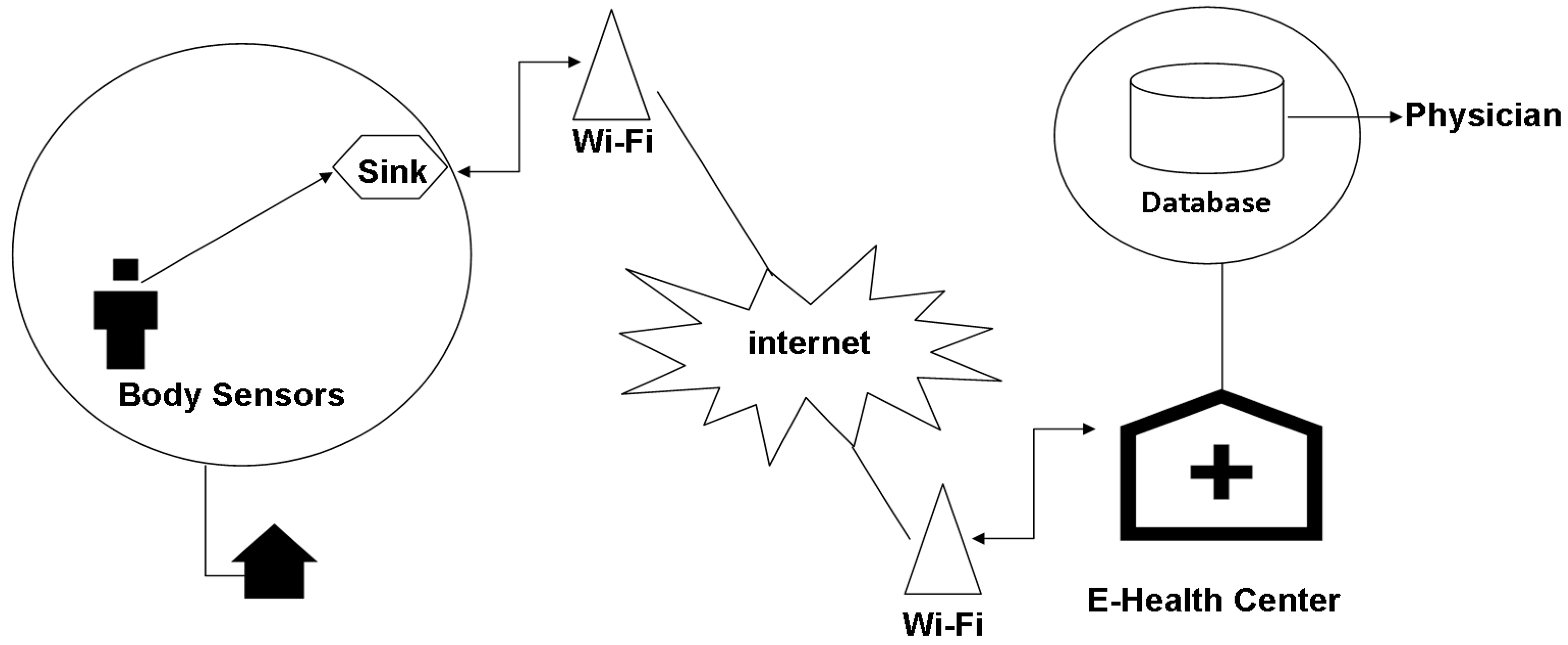
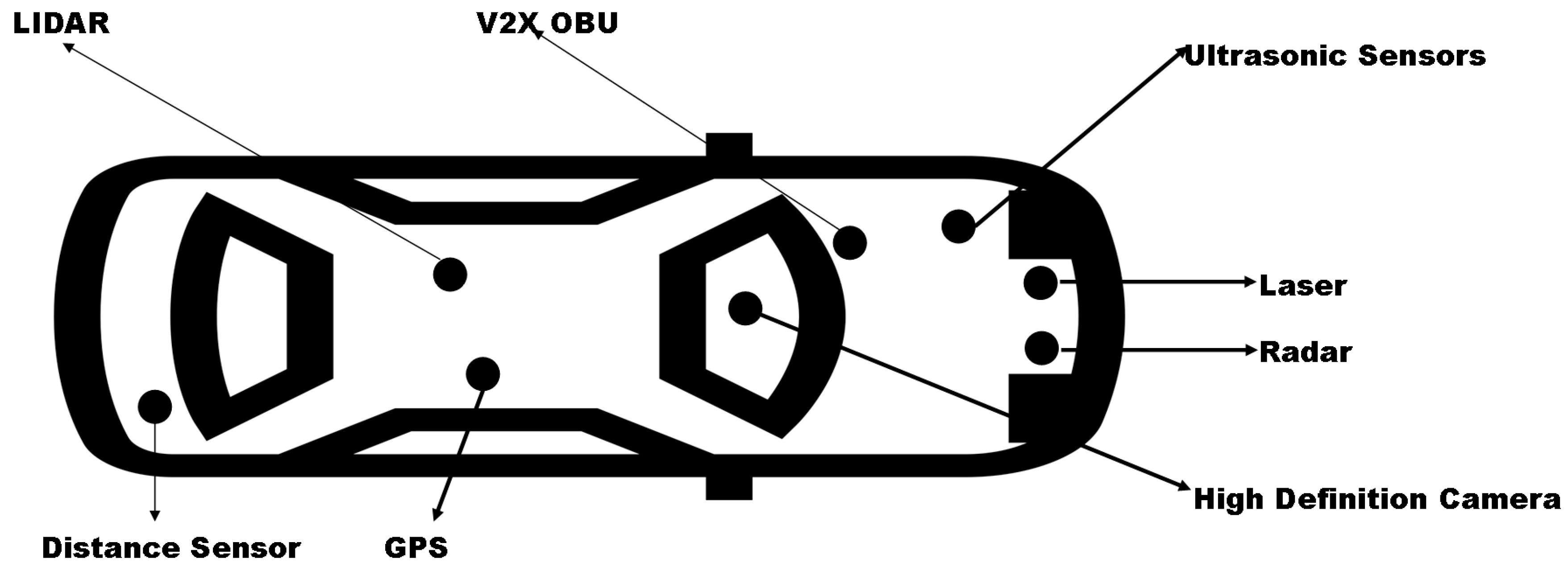
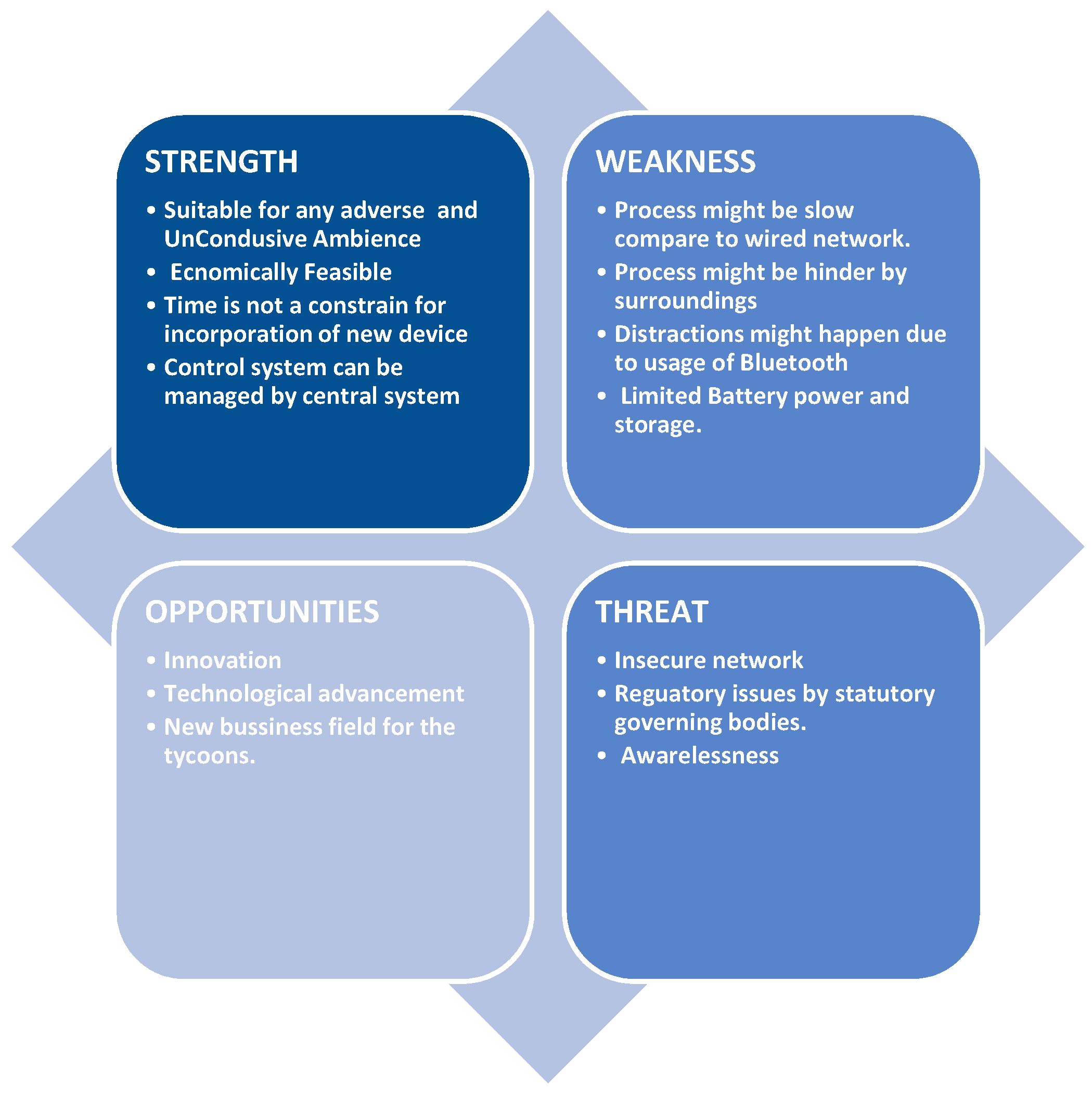
| References | Application | Sensors | City Deployed in |
|---|---|---|---|
| Boustani et al. (2011) [27] | Waste Removal | Global System for Mobile (GSM) Tracking Sensors | New York, Seattle |
| Mao et al. (2012) [28] | City See CO2 Monitoring | CO2, Temperature, Light Sensors | Wuxi, China |
| Hasanfratz et al. (2014) [29] | Air Pollution Maps | NO2, CO, O3, Ultrafine Particles (UFPs), Temperature, Humdity | Zurich, Switerzerland |
| Jiang et al. (2016) [30] | Air Quality | NO2 Sensors | Amsterdam, The Netherlands |
| References | Application | Sensors | City Deployed in |
|---|---|---|---|
| Pahuja et al. (2013) [33] | Climate Control | Vapor pressure deficit (VPD), Humidity, Temperature | Punjab, India |
| Liu et al. (2016) [34] | Intelligent Environment Control System | Multiple Sensors, illumination, Soil Moisture, CO2 | Jiangsu, China |
| References | Application | Sensors | City Deployed in |
|---|---|---|---|
| Ni et al. (2009) [36] | Gas Meter | Pressure Sensors | Taipei, Taiwan |
| Chen et al. (2011) [37] | Convenience Store | Temperature, Humidity, Micro-Electro-Mechanical Systems (MEMS), flow Sensors | Taipai, Taiwan |
| Valverde et al. (2012) [38] | Monitoring for Coffee Factory | NO, SO2, CO, pH And Water Temperature | Madrid, Spain |
| References | Application | Sensors | City Deployed in |
|---|---|---|---|
| Wark et al. (2007) [41] | Automated Cattle Monitoring | Motion Sensors, ECH2O | Queensland, Australia |
| Nkwari et al. (2014) [42] | Prevent Cattle Rustling | Markov Process, GSM, Wi-Fi | Johannesburg, South Africa |
| Wamuyu et al. (2017) [43] | Cattle Recovery System | Mobile Embedded Sensors, Worldwide Interoperability for the Microwave Access (WiMAX) | Nairobi, Kenya |
| References | Application | Sensors | City Deployed in |
|---|---|---|---|
| Mainwaring et al. (2002) [46] | Monitoring Sea Bird Nesting Environment | MICA Weather Board, Temperature, barometric pressure, passive infrared sensors | California, USA |
| Naumowicz et al. (2010) [47] | Monitor Sea Birds on Skomer Island | Temperature, Humidity, Movement, Radio-Frequency Identification (RFID), Weight | Wales, UK |
| References | Application | Sensors | City Deployed in |
|---|---|---|---|
| Son et al. (2006) [51] | FFSS—Forest Fire Surveillance System | Temperature, Humidity, Light Sensors | Daegu, Korea |
| Hefeeda et al. (2007) [52] | FWI—Fire Weather Index | Temperature, Humidity, Moisture, Temperature | Columbia, Canada |
| References | Application | Sensors | City Deployed in |
|---|---|---|---|
| Gray et al. (2011) [57] | Environmental Decision Support | Water Level Sensors | Portsmouth, UK |
| Whittle et al. (2013) [58] | WaterWiSe@SG | Temperature, Humidity, Moisture, Temperature | Singapore |
| Kim et al. (2017) [59] | SOUNET | RF (radio frequency)antenna, Underwater Modem | Mungyeong, Korea |
| References | Application | Sensors | City Deployed in |
|---|---|---|---|
| Ko et al. (2006) [61] | Improved Efficiency and Quality of Care | MiTags | John Hopkins Hospital, USA |
| Hii et al. (2011) [62] | Ubiquitous Healthcare Solution | Electrocardiogram (ECG) Sensor Node, 3G, Code Division Multiple Access (CDMA), GSM | Busen, Korea |
| Kakria et al. (2015) [63] | Real Time monitoring System | Wearable Biosensors, Android Device, Smart Phone | Pathumthani, Thailand |
| Yan et al. (2017) [64] | Structural Health MonitoringSystem | Wireless Smart Aggregate sensor, RF Module, Sampling Module, Gateway | Shenyang, China |
| References | Parameters | Sensors | Novelty |
|---|---|---|---|
| Lv et al. (2010) [67] | GSM, General Packet Radio Service (GPRS), Personal Digital Assistant (PDA), Bluetooth, Window Based Smart Phone | Temperature, Humidity, Moisture, Temperature | Quick Alarm, Regular Reminder, Medical guidance for elderly |
| Kannan et al. (2011) [68] | Body Temperature, Blood Oxygen, Heart Rate, BP | Computer, Bluetooth, GSM | Monitor major parameters of elderly people |
| Baek et al. (2013) [69] | Accelerometer and Gyroscope | ZigBee | A Fall detection system using necklace-shaped sensor node |
| Kantoch et al. (2014) [70] | Temperature, Heart Rate, Skin Humidity | Computer, Bluetooth | Monitoring activities of daily living using wearable sensors |
| Rasyid et al. (2015) [71] | Body Temperature, Heart Beat Rate, Oxygen Saturation in Blood | ZigBee, Computer | Physiological data can be accessed wirelessly through ZigBee |
| Rasyid et al. (2016) [72] | Glucose Level | Arduino Uno Board, Zigbee | Deployment of Blood glucose level monitoring system based on WBAN |
| Wu et al. (2017) [73] | Body Temperature, Heartbeat | Internet of Things | IoT associated health care application for WBAN |
| References | Application | Sensors | City Deployed in |
|---|---|---|---|
| Chatrapathi et al. (2015) [75] | Accident Management System (AMS) | Mechanical sensors, Biometric Sensors | Coimbatore, India |
| Taie et al. (2017) [76] | Secure Traffic Monitoring System (STMS) | GPS, Virtual Piconet ID (VPID) | Cairo, Egypt |
© 2017 by the authors. Licensee MDPI, Basel, Switzerland. This article is an open access article distributed under the terms and conditions of the Creative Commons Attribution (CC BY) license (http://creativecommons.org/licenses/by/4.0/).
Share and Cite
Ali, A.; Ming, Y.; Chakraborty, S.; Iram, S. A Comprehensive Survey on Real-Time Applications of WSN. Future Internet 2017, 9, 77. https://doi.org/10.3390/fi9040077
Ali A, Ming Y, Chakraborty S, Iram S. A Comprehensive Survey on Real-Time Applications of WSN. Future Internet. 2017; 9(4):77. https://doi.org/10.3390/fi9040077
Chicago/Turabian StyleAli, Ahmad, Yu Ming, Sagnik Chakraborty, and Saima Iram. 2017. "A Comprehensive Survey on Real-Time Applications of WSN" Future Internet 9, no. 4: 77. https://doi.org/10.3390/fi9040077





